In the conditions of a populated apartment, it is difficult to find an opportunity to change the tiles on the bathroom floor. Paint for floor tiles will help to update the coating. Not all compounds adhere equally strongly to ceramics, some do not have resistance against water, so the choice of material plays a role in creating a high-quality and durable layer.
Possibility of painting floor tiles
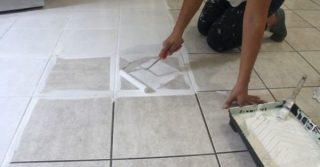
You can order work from specialists, but it is cheaper and easier to repaint the coating with your own hands. A prerequisite for high-quality painting is the correct choice of composition and surface preparation. The average life of a tile is more than 25 years, during which time the interior becomes outdated and requires renovation for aesthetic reasons.
Other reasons for the work:
- ensure the tightness of the seams;
- the opportunity to refresh the style without wet works;
- masking small chips, cracks;
- coloring the general background when replacing several tiles with elements of a different color;
- reduction of the bathroom restoration time.
Tiles, porcelain stoneware, mosaics are expensive and it is difficult to find funds to replace them every 4 to 5 years. You can paint the tiles on the floor in one color, sometimes functional areas are distinguished with different colors or an ornament is made in the form of a checkerboard, an original carpet in the center or perimeter of the floor.
The paint application method depends on the properties of the material. Use rollers, brushes. Spray guns are used on large areas; the manual method is quite suitable for a small room in an apartment. To complete the same drawings, they make stencils or buy ready-made ones in the store.
Varieties of paint
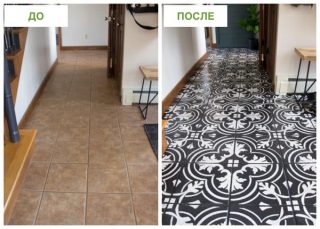
The peculiarities of the compositions are that they must have good adhesion to the surface, even if it is a glossy tile. Helmets in cans are convenient, this option is suitable for a beginner and will help create an even coating without the appearance of drips. No additional tools are required for spray painting.
Varieties of paints are used:
- alkyd enamels;
- epoxy compounds;
- polyurethane;
- water-dispersive with the addition of latex.
Any composition includes several constituent components. Pigments create color, while tinted paints are called chromatic, and black and white materials are classified as achromatic. Resins, oils, polymers, hydrocarbons are added to form a strong film upon drying.
With the help of solvents, the viscosity of the mixture is coordinated, their chemical composition is selected in accordance with the binder. During production, modifiers are added to improve performance. With their help, adhesion, wear resistance, fire resistance are increased, and color uniformity is achieved. The paint dries from several hours to one day, after which you can use the bathroom.
Alkyd enamel
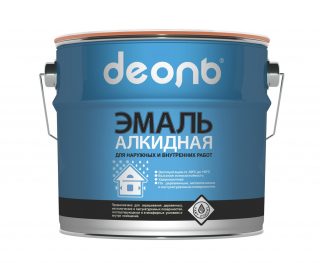
Used for interior work. Available in different colors and shades. Forms a glossy layer after drying. For breeding, before work, take turpentine, white spirit, solvent. Consumption is 80 - 130 g / m² when applied in 1 layer.
Properties of alkyd enamels:
- weather resistance, lack of reaction to fats, detergents;
- resistance at temperatures of -50 - + 60 ° С;
- water resistance, strength, elasticity, lightfastness.
To increase the protective characteristics, the enamel is applied to the primed areas. For application, use all the techniques of painting technique.
Enamels retain their gloss and properties from 4 to 6 years, and on internal surfaces they serve up to 10-12 years.
Variety of alkyd compounds are produced:
- PF - 115, 133, 223, 253, 266 - pentaphthalic alkyd;
- Extra;
- PF - 1126 - pentaphthalic with the inclusion of synthetic mastics;
- TEX-COLOR SEIDENMATTLAK - based on synthetic resins;
- KO 168, KO-112 - organosilicon;
- NTs-132 - nitroglyphthalate.
The drying time of the enamel depends on the chemical composition and the type of diluent. In the paint, varnishes, fluorides, metal oxides are used instead of varnish, which slows down the formation of a film.
Polyurethane
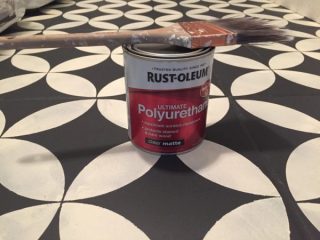
They are made on the basis of polycondensation resins. Produce one-component and two-component formulations. The first type immediately contains all the ingredients, and the second is mixed before working from two components.
Properties of polyurethane paints:
- margin of wear resistance and strength;
- compatibility with different materials and surfaces;
- ecological cleanliness;
- elasticity;
- resistance to aggressive environments.
Polyurethane paint using organic thinners is a conventional formulation modified with polyurethane copolymers. Xylene, toluene act as a solvent, pigment components are added.
It hardens the layer by the action of moisture from the atmosphere, which reacts with the ingredients in the mixture. Dry air slows down the setting, so do not dry the polyurethane paint with hot air blow dryers. The coating gains strength and is 100% waterproof for 48 hours.
Water-dispersion compositions with polyurethane filler are not used to paint floor tiles, they are taken to treat walls and ceilings.
Epoxy
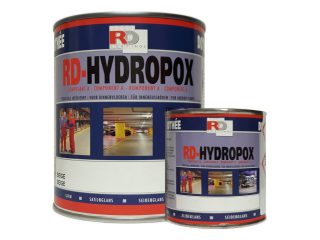
Paints are produced from resin and hardener (two-component), aerosol, powder. In everyday life, tools are used where there is an epoxy resin for cold hardening. They form a resistant film in a day without additional effect on the surface.
There is epoxy paint for tiles on the floor, which is obtained in a production environment by the hot method. Such formulations are made in one-component form, applied immediately after opening the can. The difference is that in two-component paints, the polymerisation of molecules in the film is weaker, the bonds are not as strong as in the case of using a one-component composition.
Properties of epoxy paints and varnishes:
- anti-corrosion resistance;
- neutral reaction to aggressive detergents, chemicals, atmospheric factors;
- used in the form of waterproofing due to impermeability to water;
- excellent adhesion to ceramic, concrete and other surfaces.
Mineral particles are added to the paints to create various textures, the color palette is varied, so there are advanced options for decorating the original interior.
Latex water dispersion
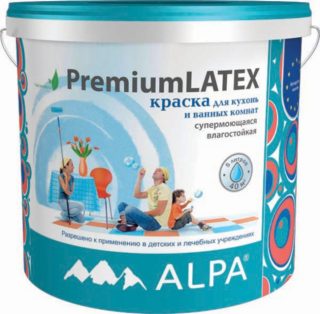
The compositions include organic or synthetic latex, also includes water, pigments, resins, as in traditional water-dispersed mixtures. When dried, the latex particles are combined, which is facilitated by the evaporation of moisture from the surface of the layer.
Qualities of latex formulations:
- durable layer, wear-resistant and durable;
- resistance to aggressive chemicals, atmospheric influences;
- no pungent odors during application and operation;
- fast drying (25 to 120 minutes);
- strong adhesion to ceramics, mosaics, porcelain stoneware;
- withstands up to 2 thousand times washing with a stiff brush using household chemicals.
There are formulations for outdoor use that can withstand multiple freeze-thaw cycles. Paint for tiles on the floor is not exposed to such an action, so you should not overpay for these qualities, but take compositions for internal use.
Before painting, the surface of the tiles on the floor is treated with an antiseptic agent against fungus and mold.
Almost all paints are sold in the form of a thick mass, which is diluted with water to the level of working viscosity before use.
Preparatory work
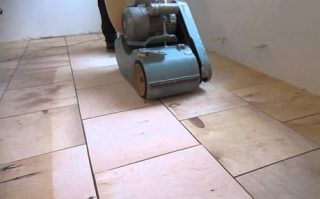
Floor tiles are produced glazed and unglazed. A smooth surface will cause any paint to come off in a month or two. Therefore, an abrasive material is used to roughen. It is impossible to create scratches manually, since ceramics are hard, so they take electric drills, grinders with special metal brush attachments.
Step-by-step order of work:
- Cleaning. The surface is washed with soapy preparations, metal brushes are used. Carefully clean the seams, while removing the old putty, which crumbles or falls out, and leave strong seams.
- Grinding. A network of marks and scratches is made on the surface to increase adhesion. There are abrasive pastes and liquids that increase the friction of surfaces.
- Degreasing. To do this, use a difference between solvents based on acetone or use degreasing preparations specially designed for this.
- Sealing with grout. Better to use epoxy and polymer mixtures.
After hardening, the seams are wiped with a wet cloth, then the floor surface is dried.
The more porous the tile, the tighter the paint will hold.
Required tools and accessories
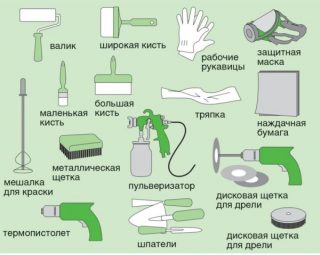
The tools are prepared in advance so that there is no delay in work. If using regular paint from a can, use a roller and brushes. The latter are needed for repainting hard-to-reach areas where the roller will not pass. The nozzle for the bathroom floor is taken in small sizes, for example, 10 - 12 cm, a lot of paint accumulates on large ones, it is inconvenient to work with them.
The attachment can be taken with a short nap, since the plane is even, without protrusions and depressions. The foam roller can only be used with water-based paints, as the material will deteriorate from the action of the solvent.
List of tools:
- a tray for paint with a shelf for wringing out the roller;
- cellophane film for covering, masking tape;
- rubber spatula, stencil, if necessary;
- drill or grinder;
- replaceable brushes for the grinder;
- rubber gloves, respirator, glasses.
Of the materials, you will need a cleaning detergent, an epoxy primer for the primer. The paint is taken according to the calculation in the required amount. To fill the joints, grout is used, and chips and cracks are sealed with a putty for the facade or glue for tiles.
The order of work
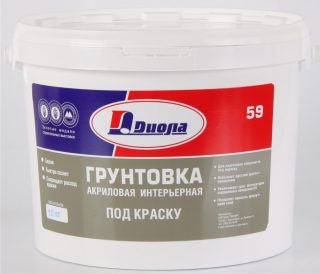
The floor area is primed after the tiles are completely dry. The primer is applied with a brush to adjust the layer thickness and not to stretch the product like a roller. Typically, such formulations dry out within a day.
Staining procedure:
- All contours of the floor are glued with masking tape, they protect the legs of the bathtub, the toilet rack and other objects in the work area.
- With a brush, paint the areas around the legs of the bathtub, toilet bowl, along the baseboards.
- The first layer is applied, the movements are performed in the forward and transverse directions, well dispersing the paint over the surface and avoiding sagging.
- Wait for the paint to dry.
- A second layer is applied, also trying to evenly distribute the composition and not leave unpainted areas.
- If necessary, apply another 1 - 2 layers.
- The surface is varnished 2 times.
They choose high-quality paint from well-known brands. Economical compositions for 1 - 2 times will not repaint the original color, you will have to buy another can. In addition, the labor intensity for subsequent paint applications will increase.
You can walk on the surface in a day, having previously checked it for stickiness with your hands.
Varnish treatment
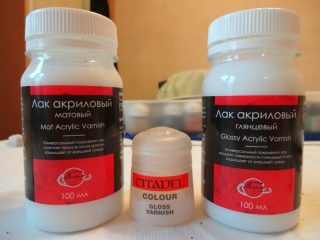
The treatment is carried out to give an additional protective layer of the surface against abrasion. The lacquered surface of the floor looks more beautiful, but the gloss due to glare shows the flaws of the tiles laid earlier. For light and white floors, choose a transparent varnish. Oil formulations can turn yellow over time, so acrylic varnishes work best.
Almost no dirt accumulates on the varnish, which makes cleaning the floor easier. The layer protects the color of the previously applied paint, as it reduces the influence of ultraviolet rays. The varnish consumption depends on the porosity of the tile and the surface texture. Spongy tiles are coated several times.
Before varnishing, the floor is cleaned of dust with a damp cloth, and wait until it dries, you can use a vacuum cleaner. The varnish is applied with a roller or brush, the first layer must completely set and dry. After that, the area is rolled a second time.








